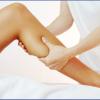CYBERMED LIFE - ORGANIC & NATURAL LIVING
CYBERMED LIFE - ORGANIC & NATURAL LIVING
 Massage – Lymphatic: Manual lymphatic drainage (MLD) is a type of massage based on preliminary evidence which is hypothesized to encourage the natural drainage of the lymph, which carries waste products away from the tissues back toward the heart. The lymph system depends on intrinsic contractions of the smooth muscle cells in the walls of lymph vessels (peristalsis) and the movement of skeletal muscles to propel lymph through the vessels to lymph nodes and then to the lymph ducts which return lymph to the cardiovascular system. Manual lymph drainage uses a specific amount of pressure (less than 9 ounces per square inch or about 4 kPa) and rhythmic circular movements to stimulate lymph flow. Clinical studies of MLD conclude that further study of the practice is required before recommending it as an effective health treatment.
Massage – Lymphatic: Manual lymphatic drainage (MLD) is a type of massage based on preliminary evidence which is hypothesized to encourage the natural drainage of the lymph, which carries waste products away from the tissues back toward the heart. The lymph system depends on intrinsic contractions of the smooth muscle cells in the walls of lymph vessels (peristalsis) and the movement of skeletal muscles to propel lymph through the vessels to lymph nodes and then to the lymph ducts which return lymph to the cardiovascular system. Manual lymph drainage uses a specific amount of pressure (less than 9 ounces per square inch or about 4 kPa) and rhythmic circular movements to stimulate lymph flow. Clinical studies of MLD conclude that further study of the practice is required before recommending it as an effective health treatment.
Manual lymphatic drainage was pioneered by Danish Drs. Emil Vodder and Estrid Vodder in the 1930s for the treatment of chronic sinusitis and other immune disorders. While working on the French Riviera treating patients with chronic colds, the Vodders noticed these patients had swollen lymph nodes. In the 1930s, the lymphatic system was poorly understood. The Vodders were not deterred by this and, in 1932, began to study the lymph system, developing light, rhythmic hand movements to promote lymph movement. In 1936, they introduced this technique in Paris, France, and after World War II, they returned to Copenhagen to teach other practitioners to use this therapy.
About 20 years, a new concept of manual lymphatic drainage, based on linear movements on the path of the lymphatic vessels towards the corresponding lymph nodes was developed by Godoy & Godoy. This technique was adapted later to the treatment of the secondary lymphedema where the main type of movement is the metorization of an intermittent compression therapy, specifically in lymphedema after treatment of breast cancer.